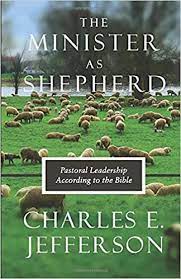
Charles Jefferson
Recommendation: 4/5
Description of author: Charles Jefferson (d. 1937) was pastor of the Broadway Tabernacle in New York City for nearly forty years.
Comments: At a time when pastors are beginning to look more and more like professional CEOs, psychologists, and managers, we are desperately in need of a reminder that pastors are . . . pastors. Pastor means shepherd and that is exactly what pastors are, shepherds. This classic work calls the pastor back to shepherding the flock – caring for people, not running an organization. Jefferson divides the book into five chapters: (1) The Shepherd Idea in Scripture and History; (2) The Shepherd’s Work; (3) The Shepherd’s Opportunity; (4) The Shepherd’s Temptations; and (5) The Shepherd’s Reward. According to Jefferson, the shepherd’s work includes being a watchman (p. 41), being a guard (i.e. protecting, p. 45), being a guide (p. 47), being a physician to the sheep (p. 50), saving the sheep (i.e. seeking the lost, p. 54), feeding the sheep (p. 59), and loving the sheep (p. 64). He writes of two temptations of the shepherd: (1) love of money; and (2) love of power (p. 99). His reminders are clear, simple and profound. Perhaps a good summary of the book is found near the middle: [The modern pastors’] common assumption has been that the work of Christ is really prosperous only when crowds are assembled in his name, and that the supreme problem of the Christian church is how to devise a Sunday service so attractive that people cannot stay away . . . Only here and there has it been recognized that the solution of the problem lies in the shepherd – one who goes where the sheep are, not with a grand declamation, but with a heart that loves and solaces and heals. He must live with the people, think with their mind, feel with their heart, see with their eyes, hear with their ears, suffer with their spirit. He must bear their griefs and carry their sorrows . . . It is the sacrificial note in the ministry which is too often lacking in these later days (p. 77, 79).